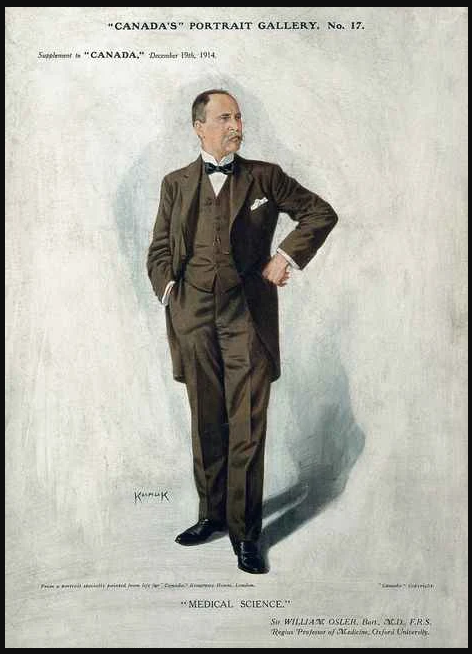Sir William Osler (1849- 1919), FRCP; a Canadian physician, was one of the four founding members of Johns Hopkins Hospital, Baltimore, Maryland, U.S. He laid the foundation of the discipline of internal medicine and developed a system of clinical medical education.
Both continue to be used in the present day of medical practice.
Introduction
Sir William Osler is regarded as the father of modern medicine and is an important influence today.
He designed the first residency training program for physicians.
He introduced the system of bedside clinical training in hospital wards outside the lecture theatres.
Osler was not only a physician but also an author, bibliophile, historian, and comedian.
His passions included medical history and creating medical libraries.
He founded the History of Medicine Society, at the Royal Society of Medicine, London.

The career of Sir William Osler
Sir Osler received his medical degree from McGill University in Montreal and then traveled to Europe for advanced training in medicine. In those days Europe was a center of advanced medical education and clinical training, and physicians from all over the world traveled to Europe for this purpose.
Osler stayed in England and subsequently taught medicine at Oxford and was later conferred a baronetcy by King George V.
He also traveled to Germany and worked under Rudolph Virchow and many other great German physicians and clinicians.
Concept of internal medicine
During Osler’s time, a new concept of innere Krankheiten, or “internal diseases,” was emerging.
This concept differentiated between diseases of the skin, or “external diseases,” and other non-surgical diseases.
This gave birth to the term innere Medicin, or “internal medicine,” for the discipline dedicated to the study and treatment of internal diseases; and Sir Osler introduced this concept in the U.S.
Until this time existing methods of medical practice involved primarily observation of the external manifestations of diseases and therapeutic interventions were based upon untested theories or traditional treatment methods.
Basic medical disciplines such as physiology, microbiology, and pathology were emerging at this time, and internal medicine applied this knowledge to the clinical care of patients.
Thus, internal medicine introduced a “scientific attitude” to the existing medical practice of that time and changed the medical mindset and methods of most contemporary physicians which continued till date.
Achievements
Sir Osler was a prolific medical writer and public speaker.His most famous book was, ‘The Principles and Practice of Medicine, first published in 1892 by D. Appleton & Company. It quickly became a popular textbook among students and clinicians.
Its many editions were published until 2001.
Its contents were: Specific Infections Diseases, Constitutional Diseases, Diseases of the Digestive System, Diseases of the Respiratory System, Diseases of the Circulatory System, Diseases of the Blood and Ductless Glands, Diseases of the Kidneys, Diseases of the Nervous System, Diseases of the Muscles, The Intoxications; Sun-Stroke; Obesity, Diseases due to Animal Parasites, Chapters and illustrations.
After 1928, its popularity was taken over by the Cecil Textbook of Medicine.Sir Osler is famous for many eponymous signs and diseases and conditions such as Osler’s nodes, Osler’s syndrome, Osler’s maneuver:(for pseudohypertension), Osler’s sign, Osler’s rule, Osler’s triad (or Austrian Syndrome), Osler–Weber–Rendu disease, Osler–Vaquez disease (also known as Polycythemia vera), Osler–Libman–Sacks syndrome (a type of endocarditis), Oslerus osleri (a nematode), Sphryanura osleri (a trematode).
He introduced the first ‘housestaff system’ for residency training and bedside teaching to medical students at the then-newly-created Johns Hopkins Hospital.
Quotes of Sir William Osler
“He who studies medicine without books sails an uncharted sea, but he who studies medicine without patients does not go to sea at all. “
– Sir William Osler
“The good physician treats the disease; the great physician treats the patient who has the disease.”
– Sir William Osler

Leave a Reply